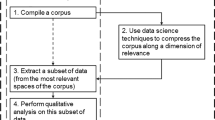Abstract
Millions of tweets are generated each day on multifarious issues. Topical diversity in content demands domain-independent solutions for analysing twitter sentiments. Scalability is another issue when dealing with huge amount of tweets. This paper presents an unsupervised method for analysing tweet sentiments. Polarity of tweets is evaluated by using three sentiment lexicons—SenticNet, SentiWordNet and SentislangNet. SentislangNet is a sentiment lexicon built from SenticNet and SentiWordNet for slangs and acronyms. Experimental results show fairly good \(F\)-score. The method is implemented and tested in parallel python framework and is shown to scale well with large volume of data on multiple cores.



Similar content being viewed by others
References
Mostafa MM. More than words: social networks text mining for consumer brand sentiments. Expert Syst Appl. 2013;40(10):4241–51.
Sachan M, Contractor D, Faruquie T, Subramaniam LV. Using content and interactions for discovering communities in social networks. In: Proceedings of the 21st international conference on World Wide Web—WWW ’12. New York: ACM Press; 2012. p. 331–40.
Rafeeque P, Sendhilkumar S. Identifying same wavelength groups from twitter: a sentiment based approach. In: Proceedings of the 5th Asian conference on Intelligent Information and Database Systems (ACIIDS’13). LNCS Vol. 7803. Berlin: Springer; 2013. p. 70–7.
Abbasi M, Chai S, Liu H, Sagoo K. Real-world behavior analysis through a social media lens. In: 5th international conference on social computing, behavioral–cultural modeling and prediction (SBP 2012), USA; 2012. p. 18–26.
Cambria E, Rajagopal D, Olsher D, Das D. Big social data analysis. In: Big data computing. London: Chapman and Hall/CRC; 2013. p. 401–14.
Wang QF, Cambria E, Liu CL, Hussain A. Common sense knowledge for handwritten Chinese text recognition. Cogn Comput. 2013;5(2):234–42.
Cambria E, Mazzocco T, Hussain A. Application of multi-dimensional scaling and artificial neural networks for biologically inspired opinion mining. Biol Inspir Cogn Archit. 2013;4:41–53.
Baccianella S, Esuli A, Sebastiani F. SentiWordNet 3.0: an enhanced lexical resource for sentiment analysis and opinion mining. In: Proceedings of the seventh international conference on language resources and evaluation (LREC’10); 2010, p. 2200–04.
Cambria E, Havasi C, Hussain A. SenticNet 2: a semantic and affective resource for opinion mining and sentiment analysis. In: FLAIRS conference; 2012. p. 202–7.
Hamdan H, Béchet F, Bellot P. Experiments with DBpedia, WordNet and SentiWordNet as resources for sentiment analysis in micro-blogging. In: Seventh international workshop on semantic evaluation (SemEval 2013), vol. 2; 2013. p. 455–59.
Montejo-Ráez A, Martínez-Cámara E, Martín-Valdivia MT, Ureña López LA. Ranked WordNet graph for sentiment polarity classification in Twitter. Comput Speech Lang. 2014;28(1):93–107.
Ghiassi M, Skinner J, Zimbra D. Twitter brand sentiment analysis: a hybrid system using n-gram analysis and dynamic artificial neural network. Expert Syst Appl. 2013;40(16):6266–82.
Kontopoulos E, Berberidis C, Dergiades T, Bassiliades N. Ontology-based sentiment analysis of twitter posts. Expert Syst Appl. 2013;40(10):4065–74.
Zhang L, Ghosh R, Dekhil M, Hsu M, Liu B. Combining Lexicon-based and learning-based methods for twitter sentiment analysis. Technical Report HPL-2011-89HP; 2011.
Tan C, Lee L, Tang J, Jiang L, Zhou M, Li P. User-level sentiment analysis incorporating social networks. In: ACM international conference on knowledge and data engineering (KDD’11), California, USA; 2011. p. 1397–1405.
Hu X, Tang L, Tang J, Liu H. Exploiting social relations for sentiment analysis in microblogging. In: Proceedings of the sixth ACM international conference on Web search and data mining. WSDM ’13. New York, NY: ACM; 2013. p. 537–46.
Speriosu M, Sudan N, Upadhyay S, Baldridge J. Twitter polarity classification with label propagation over lexical links and the follower graph. In: Proceedings of the first workshop on unsupervised learning in NLP. EMNLP ’11. Stroudsburg, PA: Association for Computational Linguistics; 2011. p. 53–63.
Khuc VN, Shivade C, Ramnath R, Ramanathan J. Towards building large-scale distributed systems for twitter sentiment analysis. In: Proceedings of the 27th annual ACM symposium on applied computing, SAC ’12. New York, USA; 2012. p. 459–64.
Cambria E, White B. Jumping NLP curves: a review of natural language processing research. IEEE Comput Intell Mag. 2014;9(2):1–28.
Cambria E, Schuller Y, Xia H. New avenues in opinion mining and sentiment analysis. IEEE Intell Syst. 2013;28(2):15–21.
Cambria E, Olsher D, Rajagopal D. SenticNet 3: a common and common-sense knowledge base for cognition-driven sentiment analysis. In: AAAI, Quebec City; 2014. p. 1515–21.
Cambria E, Hussain A. Sentic computing: techniques, tools and applications, Springer briefs in cognitive computation. Berlin: Springer; 2012.
Cambria E, Hussain A. Sentic PROMs: application of sentic computing to the development of a novel unified framework for measuring health-care quality. Expert Syst Appl. 2012;39(12):10533–43.
Chamlerwat W, Bhattarakosol P, Rungkasiri T, Haruechaiyasak C. Discovering consumer insight from twitter via sentiment analysis. J Univ Comput Sci. 2012;28(2):15–21.
Go A, Bhayani R, Huang L. Twitter sentiment classification using distant supervision. Technical Report, Stanford; 2009.
Poria S, Gelbukh A, Hussain A, Das D, Bandyopadhyay S. Enhanced SenticNet with affective labels for concept-based opinion mining. IEEE Intell Syst J. 2013;28(2):31–8.
Author information
Authors and Affiliations
Corresponding author
Rights and permissions
About this article
Cite this article
Pandarachalil, R., Sendhilkumar, S. & Mahalakshmi, G.S. Twitter Sentiment Analysis for Large-Scale Data: An Unsupervised Approach. Cogn Comput 7, 254–262 (2015). https://doi.org/10.1007/s12559-014-9310-z
Received:
Accepted:
Published:
Issue Date:
DOI: https://doi.org/10.1007/s12559-014-9310-z




